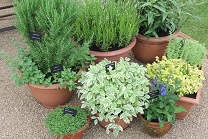 Pot plants need to be repotted regularly and if you do it correctly, you can keep plants looking good in containers indefinitely.
Pot plants need to be repotted regularly and if you do it correctly, you can keep plants looking good in containers indefinitely.
PROBLEMS WITH POTTED PLANTS IN WINTER
- Overwatering – a very common problem in winter. Potted plants need much less water in cool weather.
- Under watering – when you’re not watering the rest of the garden, it can be easy to overlook the container plants altogether. Whilst pot plants need less water in the winter, they still need some!
- Exposure to frost or wind – if a plant is likely to be damaged by cold, move it to a sheltered position, and stop fertilising tender plants in early autumn (otherwise new growth will be damaged.
- Timber pots rotting, metal pots rusting – prevent this happening by removing the plant and treating the pot with suitable preservatives.
- Lack of oxygen/air in soil – use a good quality potting mix and repot when the roots start to growth through the drainage hole.
- Environmental shock when the pot is moved to different light/shade/temperature etc conditions (This doesn’t happen with a plant settled in the same position in the ground!)
CLEANLINESS
- Make sure everything is clean where you are potting …hands, tools, pots, bench, soil etc. When roots are exposed, and often broken or bruised, the chance of infection increases.
- Dip/wipe any tools and the workbench with a bleach solution or methylated spirits.
- Wash old pots then dip them in a bleach or methylated spirits solution.
WHAT TYPE OF POT?
- The type of pot you choose depends on the plant you are trying to grow.
- Some like better drainage or drier conditions. Hanging baskets, extra drainage holes and porous terracotta work better for these plants.
- Some plants need moist conditions. A pot made from an impervious material is ideal because the potting mix won’t dry out as rapidly. Use glazed or plastic containers or paint the inside of concrete or terracotta pots.
Some like to be very wet, eg. bog plants/carnivorous plants. These plants grow well in peat moss in a container that has very little or no drainage.
POTTING MIX
Potting mix should be sterile and disease free. Always use a potting mix that shows the Australian standards symbol. The potting mix you choose will depend upon the type of plant and your budget. Brand name mixes are often more expensive and aren’t necessarily better than cheaper options.
You can make your own potting mix. Choose ingredients that will suit the particular plants you are trying to grow. For example:
- well-rotted compost
- rice hulls
- washed sand
- slow release fertiliser
- water crystals
- peat
- clay
- vermiculite
- perlite
- mature pine bark chips (without a strong pine smell)
- compost
- a good quality loam
It can be difficult to maintain clean conditions when making your own mix, and it may end up just as costly in the long term. Certain ingredients are also very good at bringing weed seeds into your potting mix. Many commercial mixes claim to be sterile, meaning that weed seeds have been killed before the product is packaged.
Alternatively, you can modify a commercial potting mix by adding extra ingredients. Add sand if your plant needs better drainage or drier soil. Add peat, vermiculite or soil wetting agents if you need more moisture. If you want to stimulate faster growth, you can add additional fertiliser. (But be careful, too much fertiliser can poison some plants.)
If you use a lot of potting mix, it is possible to buy in bulk; either by the truckload or in bags. This can save you some money, but the mix needs to be stored in a place where it can be kept free from excessive moisture and weed seeds.
WATER CRYSTALS
Water crystals can be bought from most garden centres. When water is added, they the absorb it, swelling up into jelly-like globules. If mixed with soil, this provides little blobs of watery gel throughout the root zone, which the roots can “drink” from.
In effect, water crystals are extending the soil’s ability to hold water and allowing the plant to survive for longer periods between waterings. They’re expensive, but are ideal for container plants.
FERTILISER
Nutrients wash through pots faster than through the soil in a garden bed. The answer is to feed your pot plants small amounts regularly, or to use slow release fertilisers. Many plants become dormant in winter, so reducing the need for fertilising. Generally, the only plants that need winter-feeding are those that flower in the winter, such as camellias, azaleas and hellebores.
- Liquid fertiliser is great for promoting plant growth, but it needs to be applied to pots twice as often as liquid fertiliser applied to plants in the ground (maybe weekly).
- Slow release fertilisers are great for the gardener who doesn’t have much time. Add the recommended dose 2 –3 times annually during growing periods.
- Add extra fertiliser to the mix when you are potting up. This will mean that it is spread more evenly throughout the container.